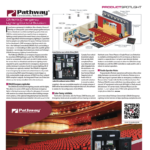Do you know how you can tell a rookie entertainment professional from a veteran? When they walk into a show, the rookie cranes his neck to admire the lighting rig while the veteran cranes his neck to see if it’s safe to walk under the rig.
As shows get larger and more complex, rigging issues become more serious. A small error in calculations can result in a big disaster. And when you have multiple rigging points with dynamic loads, things can get really hairy. And that’s no time to compromise on safety, especially when lives are at stake and there are people under the rig.
When more than two hoists are being used on a truss, or more than three hoists are used on a structure, you can encounter an unpredictable load distribution, or a phenomenon known as “statically indeterminate structure.” Even if the load appears to be balanced and equally distributed among multiple points, some of the hoists may be overloaded. It can happen to inexperienced and experienced riggers alike.
One good way to avoid this situation is to monitor the load in real time. Ron StageMaster is a wireless, multi-load-cell system that does just that. In addition to monitoring loads in real time, it also detects overload and underload situations. When certain conditions are sensed, it can set off an alarm, stop the hoists, or both, depending on how the system is configured.
The computer-based system runs on a laptop while communicating wirelessly with up to 16 or 32 load cells per channel, which are rigged in line between the chain hoist and the load. Load cells are available for loads ranging from a half ton to six tons and they are small and lightweight. They run on four AA batteries or on 110/220VAC. The load cells can operate up to 1,500 hours on one set of disposable batteries. Measured end to end, the smallest load cells are 5.5 inches and weigh 2.5 pounds while the largest are 7.9 inches and weigh 4.5 pounds each. The wireless system has a range of up to 450 feet and operates at radio frequency. The receiver is about the size of a PDA and it is housed in a lightweight ABS plastic. It connects directly to the laptop with a cable.
The software includes a load map that can be overlaid onto an AutoCAD drawing, or any other drawing converted to bitmap, to provide immediate identification of each rigging point. Names can be assigned to a group of points and individual points can be monitored or summaries of several points or the entire structure can be accessed. For larger systems, multiple systems can be used to monitor the entire rig.
Some of the parameters that the system can monitor include overload, danger, zero load, tare weights, load sums and maximum load. In addition, the resolution for the entire system can be preset. The data can be downloaded from the data log and it can store weeks worth of continuous measurements including the operator’s name, time, weights, danger alerts, overload situations, and the cumulative weight for each group. The software can be configured to display units of measure in metric tons, short tons, kilograms, pounds, newtons, deca-newtons or kilo-newtons.
With any rigging system, it’s always a good idea to design with a healthy safety factor. In this case, the load cells have a built-in safety factor of five or 10. The resolution of the load cells varies from two pounds to 10 pounds, depending on the load rating of the cell.
The system deals with the out of doors rather well. The load cells can operate in temperatures ranging from -15ºF to 175ºF and they are IP rated 65 (NEMA 4). And since there are no messy cables to deal with, the load cells can be installed quickly and easily.
The show must always go on, but there’s no reason it can’t do so safely. The Ron StageMaster system is your safety insurance policy for any rigging situation. It is an easy system to deploy and use, and it provides an extra layer of safety that can’t be matched by a rigging expert alone.


